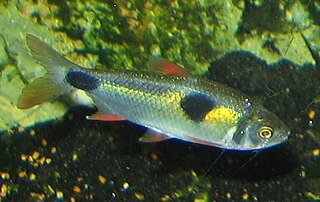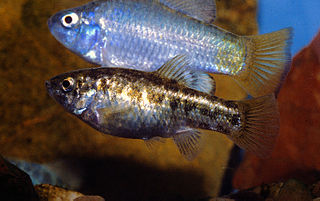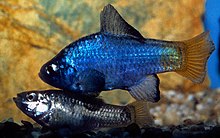
The Death Valley pupfish, also known as Salt Creek pupfish, is a small species of fish in the family Cyprinodontidae found only in Death Valley National Park, California, United States. There are two recognized subspecies: C. s. salinus and C. s. milleri. The Death Valley pupfish is endemic to two small, isolated locations and currently classified as endangered.

The Tecopa pupfish is an extinct subspecies of the Amargosa pupfish. The small, heat-tolerant pupfish was endemic to the outflows of a pair of hot springs in the Mojave Desert of Inyo County, California. Habitat modifications, the introduction of non-native species and hybridization with the related Amargosa River pupfish led to its extinction around 1979.
The Shoshone pupfish is a subspecies of Cyprinodon nevadensis from California in the United States. It is characterized by large scales and a "slab-sided," narrow, slender body, with the arch of the ventral contour much less pronounced than the dorsal. It also has fewer pelvic fin rays and scales than the other subspecies of C. nevadensis.

The Devils Hole pupfish is a critically endangered species of the family Cyprinodontidae (pupfishes) found only in Devils Hole, a water-filled cavern in the US state of Nevada. It was first described as a species in 1930 and is most closely related to C. nevadensis and the Death Valley pupfish. The age of the species is unknown, with differing analyses offering ranges between one thousand and sixty thousand years. It is a small fish, with maximum lengths of up to 30 mm (1.2 in). Individuals vary in coloration based on age and sex: males are bright metallic blue while females and juveniles are more yellow. A defining trait of this species is its lack of pelvic fins. The pupfish consumes nearly every available food resource at Devils Hole, including beetles, snails, algae, and freshwater crustaceans, with diet varying throughout the year. It is preyed on by the predaceous diving beetle species Neoclypeodytes cinctellus, which was first observed in Devils Hole in 1999 or 2000. Reproduction occurs year-round, with spikes in the spring and fall. Females produce few eggs, though, and the survivorship from egg to adult is low. Individuals live 10–14 months.

Cyprinodon is a genus of pupfishes found in waters that range from fresh to hypersaline. The genus is primarily found in Mexico, the Caribbean Islands and southern United States, but C. variegatus occurs as far north as Massachusetts and along the entire Gulf of Mexico coastline, and C. dearborni and C. variegatus are found in northern South America. Many species have tiny ranges and are highly threatened, in some cases already extinct. Cyprinodon are small; the largest reaches 10 cm (3.9 in) in length and most other species only reach about half that size.

Lepidophagy is a specialised feeding behaviour in fish that involves eating the scales of other fish. Lepidophagy is widespread, having evolved independently in at least five freshwater families and seven marine families. A related feeding behavior among fish is pterygophagy: feeding on the fins of other fish.
Potosi pupfish is a species of fish in the family Cyprinodontidae. It is endemic to Mexico, but is now extinct in the wild, only surviving in captivity.
Blackfin pupfish is a species of fish in the family Cyprinodontidae. This pupfish is endemic to Lake Chichancanab in Quintana Roo, Mexico. In almost all places, different Cyprinodon species do not overlap in their range, but there are two notable exceptions and one of these is Lake Chichancanab, which is inhabited by C. beltrani, C. esconditus, C. labiosus, C. maya, C. simus, C. suavium and C. verecundus. Among the endemic Cyprinodon species in Lake Chichancanab, only C. beltrani and C. labiosus still occur in some numbers in their habitat, while the remaining are virtually—if not fully—extinct in the wild. This species feeds on detritus. Compared to the other species of pupfish mentioned previously, the C. beltrani prefer a different feeding substrate. In regards to mating, the female blackfin pupfish seems to mate with other species of pupfish and not just the C. beltrani. The male blackfin pupfish have similar markings and courting behaviors to other pupfish in their habitat. The person honored in the specific name of this pupfish is the Mexican biologist Enrique Beltrán Castillo (1903–1994) to mark his quarter century of being a biologist.
Cyprinodon ceciliae is an extinct species of pupfish. It was endemic to the Ojo de Agua la Presa in southwestern Nuevo Leon state in Mexico, but disappeared in 1990 due to habitat loss. The same freshwater spring system was the home of three other pupfish: Cyprinodon inmemoriam (extinct), Cyprinodon longidorsalis and Cyprinodon veronicae. Although these were from the same spring system, each was restricted to its own individual spring and associated waters. The exact spring and associated waters inhabited by the Villa Lopez pupfish were also the home of a now-extinct, undescribed species of Cambarellus crayfish. The specific name honours the daughter of María de Lourdes Lozano-Vilano and niece of Salvador Contreras-Balderas, Cecilia Contreras Lozano, who assisted on the trip on which the type was collected.
The thicklip pupfish, known in Spanish as Cachorrito cangrejero, is a species of fish in the family Cyprinodontidae. The thicklip pupfish is endemic to Laguna Chichancanab in Quintana Roo, Mexico. In almost all places, different Cyprinodon species do not overlap in their range, but there are two notable exceptions and one of these is Lake Chichancanab, which is inhabited by C. labiosus, C. beltrani, C. esconditus, C. maya, C. simus, C. suavium and C. verecundus. Among the endemic Cyprinodon species in Lake Chichancanab, only C. beltrani and C. labiosus still occur in some numbers in their habitat, while the remaining are virtually—if not fully—extinct in the wild. They usually live in a tropical climate with temperatures ranging from 22 to 26 °C. The maximum total length of this fish is 7 centimetres (2.8 in).
The Parras pupfish is a small species of freshwater pupfish in the family Cyprinodontidae. It is endemic to the Laguna de Mayrán basin in southern Coahuila, Mexico. This species was widely thought to be extinct, 1903 being the date of the last recorded observation and it was declared to be extinct in 1930 until a single specimen was accidentally collected from an irrigation canal, in the town of Parras de la Fuente in 2012.
The Maya pupfish, known in Spanish as cachorrito gigante, is a highly threatened species of fish in the family Cyprinodontidae. It is endemic to Lake Chichancanab in Quintana Roo, Mexico. In almost all places, different Cyprinodon species do not overlap in their range, but there are two notable exceptions and one of these is Lake Chichancanab, which is inhabited by C. maya, C. beltrani, C. esconditus, C. labiosus, C. simus, C. suavium and C. verecundus. Living together, the Cyprinodon species in Lake Chichancanab have diverged into different niches. Pupfish typically feed on algae and detritus. In Lake Chichancanab, however, C. maya has become not only the largest species in the genus Cyprinodon, up to 10 cm (3.9 in) long, but also the only that catches and eats whole fish. In smaller quantities it eats ostracods and freshwater snails.

The Owens pupfish is a rare species of fish in the family Cyprinodontidae, the pupfish. It is endemic to California in the United States, where it is limited to the Owens Valley. It is a federally listed endangered species of the United States. This pupfish is up to 5 centimetres long, the largest males sometimes longer. The male is blue-gray, turning bright blue during spawning. The female is greenish brown with a silvery or whitish belly.
The boxer pupfish is a small species of pupfish in the family Cyprinodontidae. It is endemic to Lake Chichancanab in Quintana Roo, Mexico.
The largefin pupfish, also known as cachorrito de dorsal larga, is a small species of pupfish in the family Cyprinodontidae. It is endemic to Lake Chichancanab in Quintana Roo, Mexico. In almost all places, different Cyprinodon species do not overlap in their range, but there are two notable exceptions and one of these is Lake Chichancanab, which is inhabited by C. verecundus, C. beltrani, C. esconditus, C. labiosus, C. maya, C. simus and C. suavium. Living together, the Cyprinodon species in Lake Chichancanab have diverged into different niches. Pupfish typically feed on algae and detritus. In Lake Chichancanab, however, C. verecundus has become an amphipod- and bivalve-eater.
The Charco Palma pupfish is a species of small fish in the family Cyprinodontidae. It is endemic to the Ojo de Agua la Presa in southwestern Nuevo Leon state in Mexico. Although listed as critically endangered by the IUCN in 1996, the species is now extinct in the wild. The same freshwater spring system was the home of three other pupfish: Cyprinodon ceciliae (extinct), Cyprinodon inmemoriam (extinct) and Cyprinodon longidorsalis. Although these were from the same spring system, each was restricted to its own individual spring and associated waters. The exact spring and associated waters inhabited by the Charco Palma pupfish were also the home of three now-extinct invertebrates: An undescribed species of Cambarellus crayfish, the valvatid freshwater snail Valvata beltrani and an undescribed species of valvatid freshwater snail. The specific name honours the niece of María de Lourdes Lozano-Vilano and daughter of Salvador Contreras-Balderas, Verónica Contreras Arqueita, who assisted on the trip on which the type was collected.

The Catarina pupfish was a diminutive species of fish in the family Cyprinodontidae, first described in 1972. It was endemic to a spring in Nuevo León, Mexico. In an attempt of saving the rapidly declining species, some were brought into captivity in the late 1980s and early 1990s, but it proved very difficult to maintain. In 1994 it became extinct in the wild. Gradually the captive populations also perished. The last male died in 2014 and the species became extinct.

The desert pupfish is a rare species of bony fish in the family Cyprinodontidae. It is a small fish, typically less than 7.62 cm (3 in) in length. Males are generally larger than females, and have bright-blue coloration, while females and juveniles are silvery or tan. A notable attribute of the desert pupfish is their ability to survive in environments of extreme salinity, pH, and temperature, and low oxygen content. The desert pupfish mates in a characteristic fashion, wherein compatible males and females will come in contact and collectively jerk in an s-shape. Each jerk typically produces a single egg that is fertilized by the male and deposited in his territory. Breeding behavior includes aggressive arena-breeding and more docile consort-pair breeding.
The Death Valley freshwater ecoregion is a freshwater ecoregion in the western United States. It consists of endorheic rivers, lakes, and springs in the drainages of the Owens, Amargosa, and Mojave Rivers, in central-eastern California and southwestern Nevada.
Lake Chichancanab from Yucatec Maya "Little Sea" is a lake in Mexico located in the northwest of the state of Quintana Roo, in the municipality of José María Morelos. It is also known as Laguna Chichancanab, Laguna Chicnancanab and Laguna de Chichancanab. It has an approximate length of 30 kilometers from near the settlement of La Presumida to that of Kantemó, in the same municipality. It is the largest lake on the Yucatan Peninsula.









